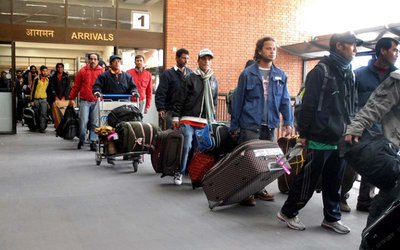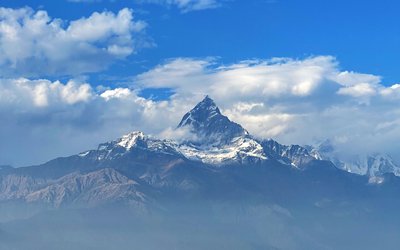The United Nations Conference on Trade and Development warns that global consumer prices will rise significantly in the year ahead until shipping supply chain disruptions are unblocked and port constraints and terminal inefficiencies are tackled.
As it is a “supply shock inflation", the rise in consumer prices would continue at least a year, because the global supply shortage cannot be overcome immediately.
The prime causes of ongoing inflation are Covid- 19 pandemic and a drop in global aggregate supply of fuels and food items following Russia Ukraine war.
Moreover, changing weather patterns are also affecting global food security. The extreme droughts are fueling food Inflation as hot weather and lack of water are causing lower yield in bread baskets in major countries of world.
As result of the global phenomenon, Nepal is also experiencing inflationary pressures both in its economy and public as well.
Nepal is excessively dependent on import of all commodities it consumes, the rise in the prices of these commodities in international market has played key role in high inflationary pressures.
The dollar-denominated food and fossil-fuel prices – has amplified the inflationary surge in our economy. These items account for a larger share of aggregate demand and household spending.
As a result of exorbitant market prices and short supply of goods, general people tend to curtail needless consumption.
Inflation can be determined by Consumer Price Index (CPI), which measures the average change in prices paid by the consumers for a market basket of consumer goods and services.
Releasing the current macroeconomic and financial situation, the Nepal Rastra Bank said that the y-o-y consumer price inflation remained at 8.50 percent in mid-October 2022 compared to 4.24 percent a year ago. Food and beverage inflation stood at 8.05 percent whereas non-food and service inflation registered 8.85 percent in the review month.
Under the food and beverage category, y-o-y consumer price inflation of restaurant & hotel sub-category increased 15.91 percent, fruit 12.06 percent, alcoholic drinks 10.24 percent, milk products & eggs 9.45 percent and tobacco products 8.44 percent.
Under the non-food and services category, y-o-y consumer price inflation of transportation sub-category increased 21.15 percent, health 10.54 percent, furnishing & household equipment 9.45 percent, education 8.11 percent and housing & utilities 7.68 percent.
In the review month, consumer price inflation in the Kathmandu Valley, Terai, Hill, and Mountain surged to 6.93 percent, 9.42 percent, 8.84 percent, and 7.07 percent, respectively. Inflation in these regions were 3.48 percent, 4.01 percent, 5.68 percent, and 3.12 percent respectively a year ago.
As result of high import from India, inflation in Nepal is usually determined by Indian inflation, attributed to having an open border, which facilitates informal trade and goods arbitrage, a rigid pegged exchange rate regime between both currencies along with comfortable capital mobility. As result of excess import dependency and continued price rises, if this situation worsened, it could trigger hyperinflation.
A country enters a stage of hyperinflation, when inflation impacts the cost of goods and services, rises uncontrollably for a period. Hyperinflation can lead people to abandon the use of the country's currency by favoring external currencies.
There is an International Accounting Standards Board definition of hyperinflation, and it is a 100% increase in the CPI over the course of three years.
The latest example of hyperinflation is Sri Lanka, where consumer prices continued their record ascent in June, with the headline rate breaching hyperinflation levels amid a persistent shortage of essentials from food to fuel.
Official data showed consumer prices in the capital Colombo rose 54.6% from a year earlier, beating predictions for a 43.7% gain in a Bloomberg survey of economists. That pushes the key price gauge past the 50% level that most economists commonly use to define hyperinflation.
Hyperinflation can lead to massive demonstrations and revolutions too; food and fuel inflation are considered one of the main reasons that caused the Sri Lanka uprisings.
Inflation has both negative and positive aspects. Negative aspects of inflation are - savers lose from inflation as prices rise, the value of money falls, and the real value of savings declines. And the workers who are stuck on fixed wages have also been losers suffered by the high inflation. An increase in interest rates can see significant rises in mortgage payments. Moreover, inflation creates uncertainty for both consumers, banks, and companies due to reluctance to invest and can lead to lower economic growth and less job availability.
Uncertainty about the future purchasing power of money discourages investment and saving. High or unpredictable inflation rates are regarded as harmful to an overall economy.
And the positive aspects of inflation are - high rates of inflation can make it easier to pay back outstanding debt. Inflation can make it easier for the government to reduce the real value of its debt by paying the debt. In a period of hyperinflation, those who own physical assets tend to be protected – such as land, factories and machines will retain their value. Farmers will benefit because the price of food continues to rise. Savers can also be protected from inflation if they can gain an interest rate higher than the rate of inflation.
There are some tools to control inflation, such as - increase interest rates, control money supply, increase the competitiveness and efficiency in economy, increase income tax and try to control wages and prices.
The Nepal Rastra Bank (NRB) has legal mandate to pursue price stability (or low) through monetary policy, which determines the size and rate of growth of the money supply. Its monetary policy goals include moderate long-term interest rates, price stability, and maximum employment.
During the high inflation period, it raises interest rates and sells government bonds on the open market discouraging borrowings to bring inflation down.
It is also our responsibility to forecast the future path of inflation and compare it with the target inflation rate. The difference between the forecast and the target determines how much monetary policy must be adjusted. The NRB target to limit inflation, this year to 7 per cent is lower than the actual inflation of the past FY 8.56% but higher than the target of the last year, 6.32%.
To control inflation, the central bank raises the Cash Reserve Ratio (CRR) and Statutory Liquidity Ratio (SLR) which reduces the lending capacity of the commercial banks by reducing flow of money from commercial banks to the public. Currently, in Nepal, the CRR to the BFIs has been increased to four percent from previous three percent and the SLR for commercial banks has been increased to twelve percent from previous ten percent.
Globally, the optimal rate of inflation is 2 to 3% for a satisfying economy. So far Nepal is concerned, according to a study conducted by Nepal Rastra Bank - the result from the study suggests that the threshold rate of inflation is 6% for the Nepalese case. When inflation is below this threshold, it does not have any significant impact on growth or it may have a slightly positive effect, whereas inflation has a significant retarding effect on growth beyond this threshold. It is thus desirable to contain inflation less than 6% to ensure that economic growth is unharmed by the pernicious effects of high inflation.
(Shrestha is a former Under Secretary at the Ministry of Finance Nepal and associated with UNDP Africa)

Hari Prasad Shrestha
He worked under Ministry of Finance, Nepal as Under Secretary and has been associated with the United Nations Development Program (UNDP) Sierra Leone and South Sudan and UNMISS.
- Encouraging Electric Vehicle Use In Nepal
- Dec 04, 2022
- Unemployment: The Biggest Challenge For Nepal
- Nov 11, 2022
- The Hunger Game
- Oct 17, 2022
- Nepal's Over Dependency And Sluggish Development
- Sep 30, 2022
- Surplus Electricity - An Opportunity For Nepalese Industry And Export
- Jun 07, 2022












